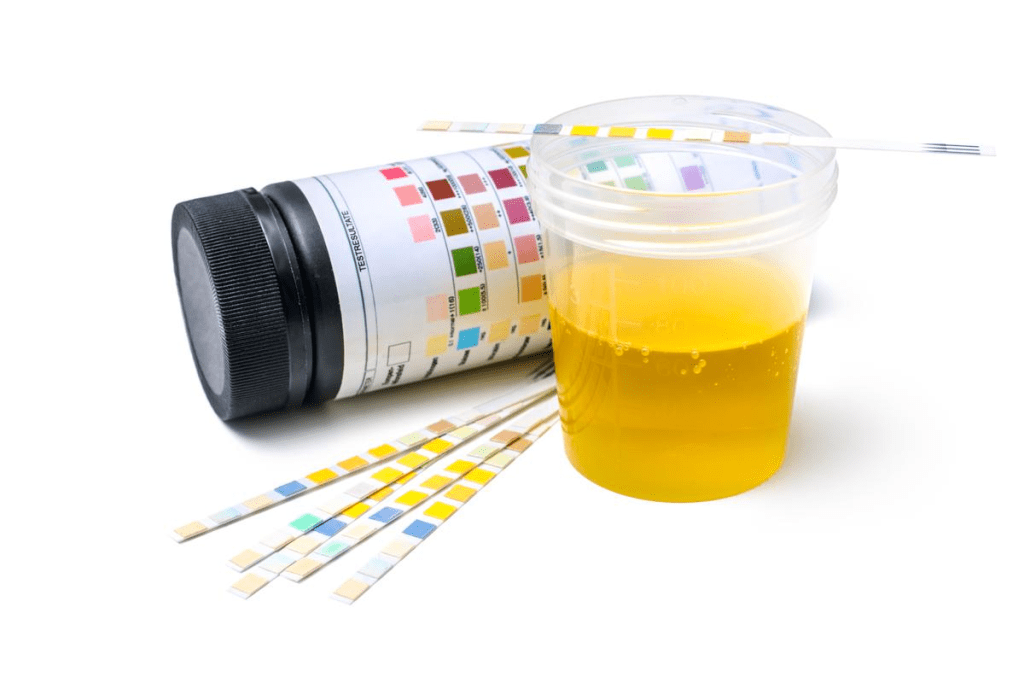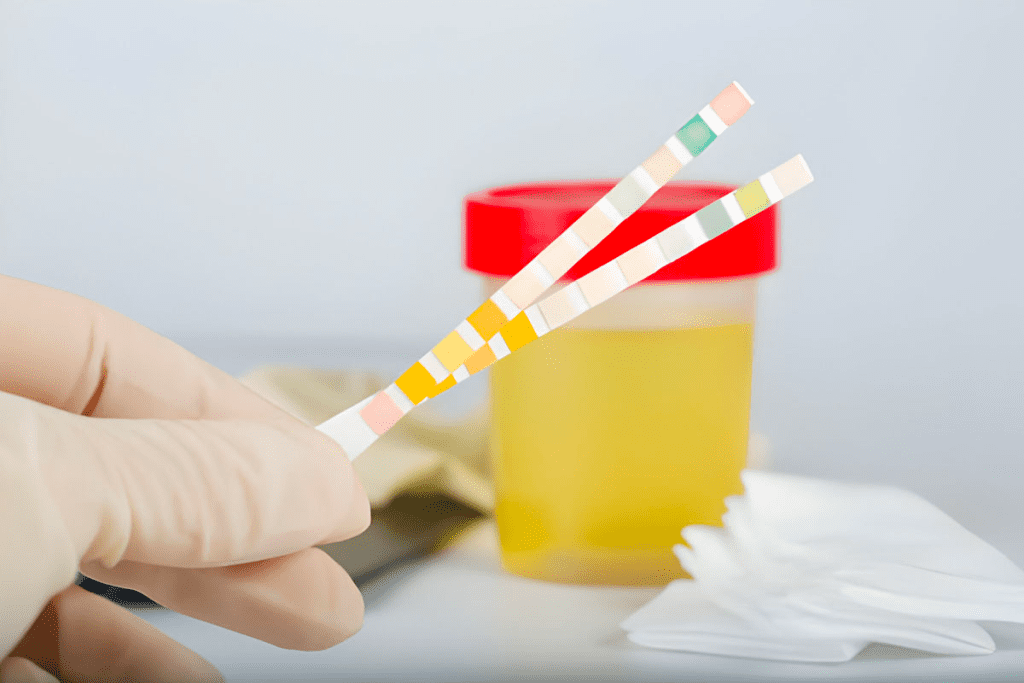Last Updated on November 25, 2025 by
Is sugar in urine? When you have glycosuria, sugar is present. Learn the negative, crucial implications of this finding for diabetes and kidney health.
Many think sugar in urine means diabetes or kidney disease. But almost every healthy adult has some sugar in their urine, even without these conditions.

Glucose in urine, called glycosuria, is normal in small amounts. But too much can mean a health problem. Knowing about glycosuria helps find and treat issues early.
Glucose in urine is not always a worry. Studies show it’s found in small amounts in healthy people. A recent study in the International Journal of Epidemiology found glucose in 99.1% of over 5,400 urine samples from healthy adults. This research has changed how we see glucose in urine, showing it’s more common than we thought.
The study used NMR spectroscopy to find glucose in urine. This advanced method can spot glucose even when it’s very low, at 0.1 mmol/L. The fact that so many healthy adults had glucose in their urine means it’s normal to have small amounts.
In healthy people, glucose in urine is usually between 0.1 and 0.5 mmol/L. These amounts are okay and don’t usually mean there’s a health problem. The kidneys help keep glucose in the blood, leaving only a little in the urine.

While small amounts of glucose in urine are normal, too much can mean a health issue. High glucose levels can show a problem with blood sugar control or kidney function. For example, diabetes makes it hard to control blood sugar, leading to more glucose in urine. Checking urine glucose can help spot health problems early.
The kidneys are key in keeping glucose levels balanced. They filter glucose from the blood and then put it back into the bloodstream. This helps keep glucose levels normal.
The process starts in the glomeruli, where glucose is filtered into the nephrons. Then, it moves to the proximal convoluted tubule. Here, the renal tubular cells reabsorb it.
SGLT2 (Sodium-Glucose Linked Transporter 2) is key in reabsorbing about 97% of glucose. This happens in the proximal convoluted tubule. It’s vital for keeping glucose levels right.
The last 3% of glucose is reabsorbed by SGLT1 in the distal segments. This ensures almost all glucose is back in the bloodstream.
Even with efficient reabsorption, some glucose can get into the urine. This is because SGLT2 and SGLT1 have a limited capacity. When glucose levels are too high, it spills into the urine, causing glycosuria.
The kidneys’ role in filtering and reabsorbing glucose is complex. It involves many mechanisms. Understanding these processes is key to understanding glycosuria and its health implications.

Glucose in urine beyond normal levels is a sign of health issues. This condition is called glycosuria.
Glycosuria is abnormal when urine glucose is over 25 mg/dl. This is important because it shows when glucose levels are too high.
The 25 mg/dl mark is key. If urine glucose goes over this, it might mean a health problem needs checking.
Blood sugar and urine glucose are linked. Normally, the kidneys filter glucose and put it back in the blood. But if blood sugar gets too high, the kidneys can’t keep up. This leads to glucose in the urine.
The point at which glucose appears in urine is around 180 mg/dl. When blood sugar hits this level, glucose spills into the urine, causing glycosuria.
Knowing how blood sugar and urine glucose relate is key to diagnosing and treating diabetes. Checking urine glucose levels helps doctors adjust treatment plans.
Important things to remember include:
Understanding these points and using a urine glucose levels chart helps doctors manage glycosuria and related issues better.
Glucose in urine can signal a problem with the kidneys or blood sugar. It’s important to know why this happens. This knowledge helps doctors find and treat the issue.
Diabetes is a main reason for glucose in the urine. It happens when the body can’t make enough insulin (Type 1) or use it well (Type 2). This makes blood sugar too high, and the kidneys can’t keep it all. Managing diabetes well is key to avoiding serious problems.
Gestational diabetes occurs during pregnancy. Hormonal changes can make insulin less effective, raising blood sugar. It’s important for pregnant women to check their sugar levels to stay healthy and protect their baby.
Kidney problems can stop the kidneys from reabsorbing glucose. This means glucose can show up in urine, even if blood sugar is normal. For example, renal glycosuria is a condition where the kidneys can’t reabsorb glucose properly.
Some medicines can change how the kidneys handle glucose or blood sugar levels. SGLT2 inhibitors, for instance, help the kidneys get rid of more glucose in urine. Other drugs, like metformin, can also affect glucose levels.
In summary, glucose in urine can come from diabetes, pregnancy-related diabetes, kidney issues, or some medicines. Knowing the cause is important for the right treatment. A doctor can figure out why and suggest the best course of action.
Renal glycosuria is a rare condition where the kidneys can’t reabsorb glucose. This leads to glucose in the urine, even when blood glucose levels are normal. It shows how complex the relationship between kidney function and glucose regulation is.
The kidneys are key in keeping glucose levels stable by filtering and reabsorbing it. In renal glycosuria, this process goes wrong, causing glucose to leak into the urine. The SGLT2 protein is mainly responsible for this glucose reabsorption in the kidneys.
Genetic mutations in the SGLT2 gene can cause renal glycosuria. These mutations stop the kidneys from reabsorbing glucose, leading to its presence in urine. Knowing the genetic causes helps in diagnosing and managing the condition.
To diagnose renal glycosuria, doctors check for glucose in urine and rule out diabetes. The main criteria for diagnosis are:
People with renal glycosuria usually have a good outlook. The condition is usually harmless and doesn’t cause serious health issues. But it’s important to keep an eye on kidney function to prevent any long-term problems.
Knowing how to test for sugar in urine is key to managing health issues. Accurate diagnosis and tracking of glycosuria depend on good testing methods.
Urine dipstick tests are a common way to find glucose in urine. These tests use a strip that changes color to show glucose. The results show if there’s glucose, how much, and if it’s present.
Urine dipstick tests are easy to use and give quick results. But, they might not be as accurate as lab tests, mainly at low glucose levels.
Laboratory tests give more precise glucose measurements. Methods like Benedict’s test or enzymatic assays measure glucose levels accurately.
Laboratory tests are best when you need exact glucose measurements for diagnosis or treatment.
Understanding urine glucose level charts is important. These charts show different glucose levels, from negative to high positive. Each level corresponds to a certain glucose concentration.
Doctors use these charts to track glucose level changes. They adjust treatment plans based on these changes.
How long sugar is detectable in urine varies. It depends on the amount, kidney function, and metabolic rate.
Generally, glucose is detectable in urine for a short time. But the exact time can change based on health conditions and the sensitivity of the testing method.
Knowing how long sugar stays in your system helps in managing glycosuria effectively.
Knowing about glycosuria, or sugar in urine, is key to staying healthy. As we’ve seen, a little bit of glucose in urine is okay. But too much can mean there’s a health problem.
Sugar in urine can point to several issues. This includes diabetes, gestational diabetes, and kidney problems. These problems affect how the body handles glucose.
It’s important to know why glucose levels in urine are high. This helps doctors diagnose and treat problems quickly. By understanding how blood sugar and urine glucose are connected, people can manage their health better.
Testing urine for sugar regularly is a good idea. It can catch health problems early. Knowing about glycosuria helps people stay healthy and avoid serious issues.
Glycosuria is when glucose is found in the urine. It’s normal in small amounts, but can signal health problems if levels are high.
The kidneys filter glucose from the blood. Proteins SGLT2 and SGLT1 then reabsorb most of it back into the blood. A small amount is left in the urine.
Normal glucose levels in urine are between 0.1-0.5 mmol/L. Research shows glucose is found in 99.1% of healthy adults’ urine.
Sugar levels in urine are a concern when they’re over 25 mg/dl. This can mean diabetes or kidney problems.
Blood glucose levels above 180 mg/dl cause excess glucose to be excreted in urine.
Yes, some medications, like Metformin 500, can change how glucose is reabsorbed. This can lead to glycosuria.
Renal glycosuria is a rare condition. It happens when the kidneys can’t reabsorb glucose, even with normal blood sugar levels. This causes glucose to spill into the urine.
Sugar in urine is tested with urine dipstick tests and lab analysis. The results are read using a urine glucose levels chart.
Sugar’s detectability in the system varies. Knowing this is key to diagnosing and managing glycosuria.
Glycosuria is important for health. It can show underlying health issues that need medical attention.
Subscribe to our e-newsletter to stay informed about the latest innovations in the world of health and exclusive offers!